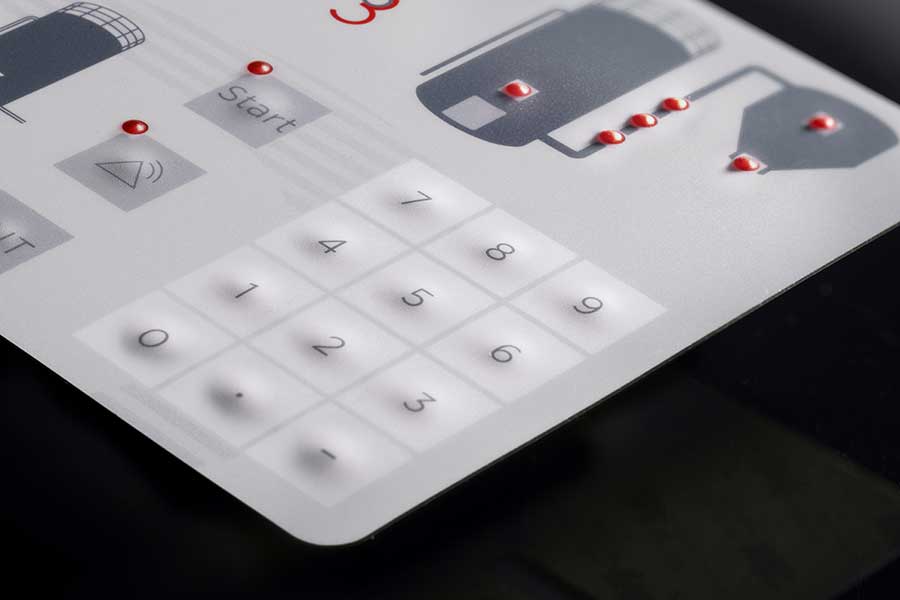Innovations in Membrane Switches for Touch-Sensitive Devices
Innovations in Membrane Switches for Touch-Sensitive Devices
Blog Article
Comprehending the Significance of Membrane Switches in Interface
Membrane switches are essential parts in the style of efficient individual interfaces, promoting not just functionality yet likewise boosting visual appeal and user communication. As we check out the future fads and different benefits connected with Membrane innovation, it becomes clear that these buttons are a lot more than just elements; they represent a convergence of technology and functionality.
What Are Membrane Buttons?

The spacer layer, which consists of glue residential properties, enables the separation of the circuit layer from the overlay, making certain that the button continues to be in a non-activated state until pressed. When pressure is applied to the overlay, it compresses the spacer layer, connecting the space and completing the circuit in the underlying layer. This design not just decreases the physical area needed for standard mechanical buttons however likewise boosts the sturdiness of the gadget, as Membrane buttons are typically resistant to dust, moisture, and various other environmental elements.
Generally found in applications varying from customer electronic devices to medical devices, Membrane buttons are integral to modern technology, supplying a user-friendly and effective user interface that aligns with contemporary style requirements.
Advantages of Membrane Switches
While numerous switch technologies exist, Membrane Switches deal distinct benefits that make them particularly preferable in different applications. Among the main advantages of Membrane switches is their small layout, which permits space-saving implementations in tools where property is limited. Their slim profile not only boosts aesthetic charm but likewise promotes lightweight construction.
An additional significant benefit is their resistance to environmental factors. Membrane switches are usually sealed versus wetness, dirt, and impurities, making them ideal for use in demanding settings, such as clinical devices and commercial devices. This toughness expands the lifespan of the switch, minimizing maintenance costs and enhancing reliability.
Moreover, Membrane switches can be customized to fulfill specific design needs, integrating special graphics and shades that improve user interaction. Their responsive comments options can also be customized to offer a rewarding user experience. Additionally, Membrane switches are affordable, especially in high-volume applications, as they can be created effectively.
Applications in Different Industries

In the consumer electronics field, Membrane switches are common in gadgets such as microwaves, cleaning equipments, and remotes. Their responsive feedback and visual options boost user experience while offering a company website streamlined, contemporary appearance. Additionally, automotive manufacturers use Membrane switches in dashboard controls and infomercial systems, where area is restricted, and individual interaction is essential.
In addition, the industrial field leverages Membrane buttons in control panels for equipment and equipment, permitting user-friendly operation in often rough atmospheres. Their resistance to chemicals and wetness makes certain longevity and reliability in these applications. On the whole, the versatility of Membrane Switches contributes significantly to their extensive use, making them crucial in different technological domain names.
Design Considerations for Membrane Buttons

When making Membrane switches, numerous crucial factors to consider should be taken right into account to ensure optimal performance and user experience. To start with, the choice of products is essential; picking durable, high-quality substrates can boost the switch's durability and resistance to ecological factors such as moisture and temperature level changes.
Second of all, the layout of the graphic overlay need to prioritize quality and ease of usage. Symbols and message have to be clear, and the format needs to help with instinctive communication (membrane switches). Furthermore, responsive feedback is vital; integrating a tactile dome or various other devices can enhance the individual experience by supplying physical confirmation of activation
One more vital factor is the button's electrical performance. Developers have to ensure that the conductive traces are properly designed to decrease resistance and stay clear of signal disturbance. This involves examining the required actuation force and making certain compatibility with the electronic parts they will certainly interface with.

Future Trends in Membrane Technology
As innovation remains to advancement, Membrane buttons are poised to develop substantially, driven by innovations in materials and manufacturing methods. One arising fad is the consolidation of innovative products, such as adaptable substrates and conductive inks, which boost durability and minimize the overall weight of Membrane buttons. These materials not just improve the tactile reaction but also enable for the design of switches that can endure harsher ecological problems.
Additionally, the integration of touch-sensitive modern technologies is changing standard Membrane Switches into even more interactive interface. Capacitive touch sensors installed within Membrane switch panels can give a more user-friendly and responsive user experience, aligning with the growing need for streamlined, modern-day layouts in customer electronic devices.
Additionally, improvements in printing methods, such as digital and 3D printing, allow fast prototyping and customization of Membrane switches. This adaptability permits makers to respond extra quickly to market demands and consumer choices.
Finally, sustainability is ending up being a considerable emphasis, with makers exploring environmentally friendly materials and procedures. As these trends unravel, the future of Membrane innovation promises enhanced performance, aesthetic appeal, and ecological duty, strengthening their role in sophisticated user interfaces throughout various sectors.
Final Thought
In conclusion, Membrane Switches represent a vital component in the design of user interfaces, combining capability with aesthetic flexibility. As improvements in modern technology continue, the development of Membrane switches is anticipated to more improve customer interfaces, driving development and enhancing usability in a significantly complex technological landscape.
Membrane buttons are indispensable parts in the design of efficient individual interfaces, assisting in not only performance however likewise boosting visual charm and individual communication.Membrane Switches serve as a crucial part in various customer interfaces, assisting in a seamless moved here communication between users and digital tools.While many switch modern technologies exist, Membrane Switches offer distinct benefits that make them particularly preferable in various applications.Moreover, Membrane switches can be customized to satisfy certain layout demands, including special graphics and colors that enhance individual interaction.In verdict, Membrane Switches represent a vital element in the design of user interfaces, incorporating capability with visual versatility.
Report this page